Part Four: The Tribal Village of the Embera
We’ve come a long way with technology. This to me is science. I like to stay at the forefront – the leading edge, and all the other buzzwords you can think of that have to do with technology. I sometimes buy devices and gadgets with the full intention of returning them within the fourteen-day window just so I can become familiar with them, learn all about them, and be able to speak intelligibly of them. I would never personally own a Windows phone, but I was quick to hop on my mother’s for an hour or two when she got it, just to check out what they’re all about. I have more gadgets and technology in my house than a Best Buy distribution warehouse. Well, one that’s very small and only has like five laptops and three tablets in it.
I never dreamed I could part with my tech so easily. And maybe I can’t. I brought my tablet and my D/SLR camera with me on this trip to Panama. And my cell phone. And my wife’s laptop, her cell phone, a pocket camera, a 3G wireless hotspot, a GRUB analyzer, a Trip Socket spectrometer, and a bag full of cords, cables, chargers and SD cards. I came fully prepared. Our phones, however, remained off the entire trip. It was nice to be disconnected. Sort of. Not sort of nice. Sort of disconnected. Of course we still fired up Lync and Google Talk to video chat with the kids in the evenings, and I checked my email on my tablet and sent my drawings to my game mates on Draw Something. But we were more off-the-grid than usual. Especially when we went to see the Indians.
The only technology we took with us was a camera, and in fact, I mentioned to Two-Step on the ride out there that had I to do it all over again, I’d make the trip twice. And the second time come without a camera. I hate the thought of missing that perfect photo-op, but we wanted to shed our civilization and our technological comforts to be more engrained in this excursion. We were going to visit an indigenous village of the Embera Indians.
These people migrated from Darien – the dense forest between Panama and Columbia that marks the only gap in the Pan-American roadway – back in the 1980s. And they’ve lived in primitive huts and villages from the beginning. They wear no shoes, and very little clothing, and live completely off the land. Well, some things have changed in the last few years.
The government of Panama made it illegal to hunt. They therefore became dependent on society to provide them with certain things. In return, the government persuaded them to open their village to tourism. On the islands where the Embera live, there are six villages consisting of twenty-one families. One of these villages is a tourist-friendly area where they trade with visitors and educate them on the Embera customs and lifestyle. Each of the twenty-one families is represented in the main hut where they sell hand-made goods for money to buy meat, cloth, and other things they need. You can read all about Embera Indians on the internet. But I’d like to tell you of our experience with them.
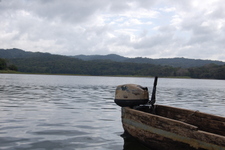 We were the only ones in our group who were interested in visiting the indigenous people, so my red-haired wife and I had a tour guide all to ourselves. This made for a very memorable trip. On the way out to the village, which was nearly two hours’-worth of driving, he made a phone call, and then promptly turned up the radio. Within seconds, the song ended and the DJ came on saying, “Bienvenido Stephanie y Brian de Dallas, Texas!” quickly followed by salsa music. This was a sort of keystone for the direction our tour was to go. When Otto had initially turned the radio to an American music station, I had quickly told him I would rather hear the local music. We wanted to completely immerse ourselves in the culture. We had worn our swim trunks and sandals too, and shed them as soon as we were able. There were some forty other tourists who ended up at the village at the same time we were there, but we were the only ones who looked like Embera. For we had stripped to our swimsuits and bare feet to join them. To be more like them. To experience the full effect of the tour the way they live it.
We were the only ones in our group who were interested in visiting the indigenous people, so my red-haired wife and I had a tour guide all to ourselves. This made for a very memorable trip. On the way out to the village, which was nearly two hours’-worth of driving, he made a phone call, and then promptly turned up the radio. Within seconds, the song ended and the DJ came on saying, “Bienvenido Stephanie y Brian de Dallas, Texas!” quickly followed by salsa music. This was a sort of keystone for the direction our tour was to go. When Otto had initially turned the radio to an American music station, I had quickly told him I would rather hear the local music. We wanted to completely immerse ourselves in the culture. We had worn our swim trunks and sandals too, and shed them as soon as we were able. There were some forty other tourists who ended up at the village at the same time we were there, but we were the only ones who looked like Embera. For we had stripped to our swimsuits and bare feet to join them. To be more like them. To experience the full effect of the tour the way they live it.
This is beautiful country, only accessible by boat. As we came out of the van and approached the shoreline, there was a small child and a man standing on a wooden canoe waiting for us. They of course spoke no English. These were the Embera coming to collect us. As we settled in and donned life jackets (which I was completely opposed to but bound by policy to do) I saw the boy leaning over the edge of the boat, pulling handfuls of water to his mouth for drinking. Straight from the river. Clearly, he was the real thing. The boats have motors. Clearly, the tourism demands it. 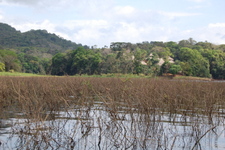 But without tourists, they wouldn’t need them. It took forty minutes or so of navigating through uncharted (to us) waters, around islands and through hidden branches to get to where we were going. By the time we arrived, we were so far from civilization as we knew it that it was hard to believe it existed. There was nothing out here. We had traversed swamps thick with lily pads and broken branches, crossed through natural spillways almost too narrow for the boat to pass and under cavernous overhanging trees into hidden waterways. It was truly secluded. And completely breathtaking.
But without tourists, they wouldn’t need them. It took forty minutes or so of navigating through uncharted (to us) waters, around islands and through hidden branches to get to where we were going. By the time we arrived, we were so far from civilization as we knew it that it was hard to believe it existed. There was nothing out here. We had traversed swamps thick with lily pads and broken branches, crossed through natural spillways almost too narrow for the boat to pass and under cavernous overhanging trees into hidden waterways. It was truly secluded. And completely breathtaking.
Our first stop was an island with a small creek that ran to the river. We followed this creek on foot back into the jungle for a good half-mile or so before it terminated in a beautiful cascade where we stripped down and jumped into the seventy-degree water. Funny that, at home I can’t get my red-haired wife into an eighty-five-degree pool. But here she bounded right in and said it felt great. We bathed under the waterfall and splashed around while the other tourists stood around in their clothes, completely unprepared for such an excursion. Why go on one of these tours if you don’t plan to go all the way? Why not experience it full-on, to the fullest extent of fullality? Why, in other words, would you not come to a cascade with swim trunks? 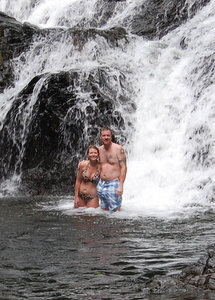 Well, I went a step further and said why would you wear shoes to visit the tribe in their village? They don’t wear shoes, so nor shall I.
Well, I went a step further and said why would you wear shoes to visit the tribe in their village? They don’t wear shoes, so nor shall I.
After swimming in the cool water, we made the trek back to the canoe where the driver took us to his village. As we arrived, we realized we had found the drums.
On our descent in the gondola through the rain forest a couple of days before, we had heard the beating of tribal drums from somewhere distant – as far as the horizon. But the sound had carried as there were no car horns, airplanes or city streets to drown the sound. It was spine tingling in the forest. Not quite being sure the origin, but knowing only that it’s human was spooky, yet also very attractive to the sense of curiosity. Was it a tribe familiar with civilization? Or was it a long-lost forgotten band of indigenous woodsmen who had never seen a white man? Just an interesting chain of thoughts that rolled through my head as we approached the end of the rainforest tour.
Now as we pulled onto land, we were greeted with those same drums! But we could now also hear the accompanying music made by flute and tambourine and maraca. The tribe was standing ashore welcoming us to their village. It was an incredible moment for us, who have never been exposed to a forgotten tribe of primitive folk.
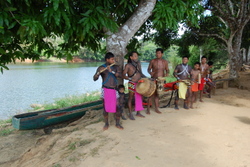 The village itself was unremarkable by our high-tech standards. There was no brick or steel, of course – it was all wood and palm frond. Not altogether poor craftsmanship, but nothing that just screamed of a primitive hand. We were led into a large hut surrounded by tables where each of the families displayed their wares. There were also several rows of benches where the visitors were invited to sit while the chief of the entire village explained to us (through a translator) how they made each of the items, and how they went about their lives.
The village itself was unremarkable by our high-tech standards. There was no brick or steel, of course – it was all wood and palm frond. Not altogether poor craftsmanship, but nothing that just screamed of a primitive hand. We were led into a large hut surrounded by tables where each of the families displayed their wares. There were also several rows of benches where the visitors were invited to sit while the chief of the entire village explained to us (through a translator) how they made each of the items, and how they went about their lives.
The Embera fed us on plates they had made of palm leaves wrapped round like a cone, and pinned in place with a wood chip, and adorned with fresh hibiscus flowers. It was a small serving of fresh fish, roasted plantains and pineapple. This was probably the freshest food we’ve ever seen, having just been picked, pulled and prepared that morning straight from its birthplace. They showed us tribal dances accompanied by the tribal instruments, and invited us to dance with them. Then they allowed us to browse their goods and explore their village while some of them walked around offering to tattoo our skin as they do their own. They use a sort of vegetable ink that stays on your skin for about a week, then sloughs off naturally. It was a very unique experience, and very well worth the time, money and effort involved in the tour. There were, however, some disappointments for me.
I know these people are exposed to tourism as part of their daily lives. So they’re not nearly as secluded as I had expected. I saw bits of technology around their village. A plastic bucket here, a steel manufactured knife there. A plastic toy tricycle under one of the stilted huts. It wasn’t entirely primitive, understandably. But these little things weren’t offensive either. I just felt like we should have been allowed to engage more with the Indians. To experience more of their day-to-day comings and goings. My real dream would have been to stay with them for a week and live the way they live, shedding myself of all contemporary comforts. But then, I would have wanted it to be a real seclusion – apart from the touristy version we visited. Just my wife and I, visiting a village of indigenous peoples who never see other tourists. Who don’t know modern technology. But then, maybe that’s asking too much.
We just didn’t get to experience near the amount of things I had questions about. I wanted to go fishing with the boys. Have the little girls show me what they do for fun in lieu of Barbie dolls and iPods. We watched several little girls playing with a large balloon someone had brought – trying to keep it from landing – and realized this was probably the height of their entertainment for the day. Their faces were beautiful with smiles and laughter as they fumbled around for long minutes with the simplicity of a balloon. It was wonderful to see them so happy. If I could entertain my children with balloons, I could save thousands of dollars a year on tech gadgets. That I could then spend on myself.
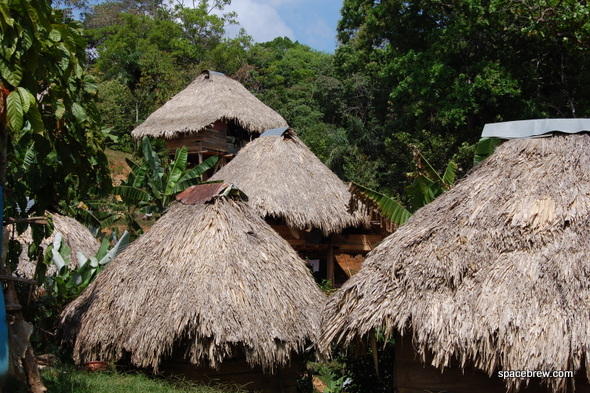
Alas, the trip wasn’t everything I expected, but also worlds beyond what I could have imagined. It was bitter and sweet. I learned more from this trip than I did from any of the others. It was truly and remarkably life-changing. And it was with a heavy heart that we said goodbye to the villagers as we walked back down to the canoes where they would take us back to civilization. Back to our van. Back to the hotel where we’d awake the next morning and head back to the airport. Back home to our lives, to our technology, to our civilized world of school buildings and refrigerators. My Friday-night poker games in luxurious metal folding chairs with plastic playing cards. My wife’s simple pleasures of watching comedy shows on television while my children play on tablets and X-boxes.
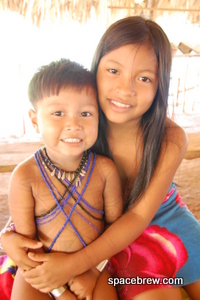 They all came out of the hut to wave goodbye, smiles wide on their faces as if we were the only tourists they had ever invited into their home. The two children who had fought for Stephanie’s attention as we sat getting our tattoos, Avail and Kaylee (I’m obviously not sure of the spelling, but these are phonetically accurate) were sad to see us go. They looked as though they might actually cry. And we felt as though we might. These beautiful children wanted to be a part of our lives as much as we theirs. Perhaps they even wanted to come back with us. To see what life would be like outside the rainforest. These children had never leaned over the metal rail of a balcony to overlook the Chagris River upon which they live. Only the bamboo rails of a wooden hut, from ten feet up. They had probably never seen a television program. The little girls had never giggled watching Doc McStuffins heal her stuffed animals in make-believe land. But then my little girls had never eaten a slice of watermelon their mother had just pulled from the garden either.
They all came out of the hut to wave goodbye, smiles wide on their faces as if we were the only tourists they had ever invited into their home. The two children who had fought for Stephanie’s attention as we sat getting our tattoos, Avail and Kaylee (I’m obviously not sure of the spelling, but these are phonetically accurate) were sad to see us go. They looked as though they might actually cry. And we felt as though we might. These beautiful children wanted to be a part of our lives as much as we theirs. Perhaps they even wanted to come back with us. To see what life would be like outside the rainforest. These children had never leaned over the metal rail of a balcony to overlook the Chagris River upon which they live. Only the bamboo rails of a wooden hut, from ten feet up. They had probably never seen a television program. The little girls had never giggled watching Doc McStuffins heal her stuffed animals in make-believe land. But then my little girls had never eaten a slice of watermelon their mother had just pulled from the garden either.
The trip back to the hotel was with mixed emotion, and pregnant with memory and words unspoken. We were simply too overwhelmed to speak. But both of us would have said the same thing. And eventually, when words found us again, we did say the same thing. On our next trip to the country, this is the first place we plan to bring our children. I think they would benefit greatly from such an exposure. And we will come back. Sooner rather than later. We now have friends we would like to call on.
Tomorrow I wrap up the Panama Chronicles with thoughts and takeaways from the trip, and a few more photos we took along the way. Thank you for joining me on this journey back through my memories. See you soon.

WOW! What a phenomenal experience. Sounds amazing and wonderful!